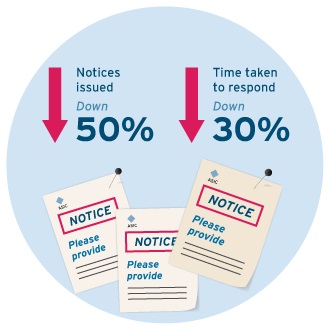The market integrity report highlights some of ASIC's achievements from 1 January 2015 to 30 June 2015, and outlines our key priorities for the rest of 2015.
The market integrity report consists of a three minute video and this webpage.
Market integrity matters!
Market integrity affects all Australians. Over 36% of adult Australians own shares or other listed investments directly or indirectly. This equates to 6.48 million Australians![1]
ASIC is responsible for the supervision of trading on Australia's domestic licensed markets. We supervise 18 financial markets, on which more than 960,000 trades are made per day.[2]
As the markets regulator, ASIC's core priority is the promotion of investor confidence through fair, orderly, transparent and efficient markets.
ASIC market surveillance
ASIC continues to invest in technologies that assist us to identify complex crimes and patterns of behaviour. An example of this is our ability to create an instant snapshot of any security or trading account to determine whether trading is suspicious.
Improved access to data means that we are issuing almost 50% fewer notices for information from market participants. We have been told that our more targeted notices are resulting in significant time savings for recipients.

In June, ASIC implemented the Market Entity Compliance System (MECS). MECS is part of ASIC’s industry-funded Flexible Advanced Surveillance Technologies (FAST) program. MECS provides market intermediaries with the tools and information to help them comply with their regulatory obligations.
MECS is an example of ASIC using technology to assist market intermediaries to comply with the law.
Key statistics
- 18,388 trading alerts
- 102 market surveillance inquiries
- 37 matters referred for further investigation
- 164 industry meetings (including 98 compliance liaison meetings)
- 25 compliance surveillances
- 14 risk-based assessments.
Market integrity enforcement
ASIC vigorously investigates and prosecutes market misconduct. Our markets integrity enforcement team typically had over 100 matters under investigation at any one time during the period. ASIC achieved a total of 11 significant market integrity enforcement outcomes during this time. This included four criminal convictions for insider trading, two continuous disclosure outcomes, three market manipulation outcomes and two outcomes for ASIC market integrity rule breaches.
One important outcome in the period was the sentencing of Lukas Kamay and Christopher Hill to jail terms of seven years and three months and three years and three months, respectively, for their roles in Australia’s largest insider trading scheme. This crime was uncovered by a joint investigation between ASIC and the Australian Federal Police.The lengthy sentences imposed on these men sends a clear message about the seriousness with which ASIC and the courts regard conduct which affects market integrity.
Market infrastructure
ASIC monitors market trends to ensure our regulatory responses are appropriate, timely and effective.
ASIC is reviewing high-frequency trading (HFT) activity in Australia, and considering whether things have changed since our 2012 review. In addition, we are examining HFT in the futures market. ASIC is also reviewing dark liquidity and dark trading venues in our market. Key findings from our analysis of HFT and dark liquidity will be published later this year.
Robust listing standards are fundamental to investor confidence. ASIC is undertaking an assessment of exchange listings standards in Australian markets. We will publish our findings in the second half of 2015.
ASIC is continuing to implement the Group of Twenty (G20) over-the-counter (OTC) derivatives reforms. This work includes upgrading our surveillance capabilities and undertaking analysis of trends and behaviour in OTC derivative markets. ASIC has also made substantial progress in implementing a requirement to centrally clear certain trades through central counterparties.
ASIC's future focus
Three areas of ongoing focus for ASIC are cyber resilience, confidential information and conduct risk. ASIC has been actively campaigning to increase awareness of the potential consequences of, and our expectations regarding, these issues.
Conduct risk
Since late 2013, ASIC has been undertaking a substantial program of work in relation to conduct risk. ASIC's '3 C's conduct message' (communication, challenge and complacency), together with information about better practice and areas of concern, has been extensively communicated. To date, ASIC presented on conduct risk to over 1,700 bankers.
Earlier this year, ASIC issued a 'Conduct Calculator' to 19 investment banks. The Conduct Calculator covers the frameworks, tools, practices, controls and programs used by investment banks to manage conduct risk as it relates to their Australian investment banking, sales and trading operations. We subsequently issued a feedback report to participants to enable them to compare their response against the aggregated survey results.
Cyber resilience
Cyber attacks are a major risk for market intermediaries. ASIC has an important role to play in encouraging cyber resilience. In March 2015, we published a cyber health check to assist businesses assess their cyber resilience: see Report 429 Cyber resilience: Health check (REP 429).
We also issued warnings to market intermediaries about cyberattacks in the ASIC Market Supervision Update (MSU).
We will continue to monitor market intermediaries' cyber resilience and work with affected businesses to ensure market integrity is not damaged.
Confidential information
The leakage of confidential, market-sensitive information about a listed entity threatens market integrity by creating selective access to information. This may damage investor confidence and increase the risk of insider trading.
Since the publication of Report 393 Handling of confidential information (REP 393) in 2014, ASIC has continued to examine the way companies and their advisers handle confidential information. We conducted a review of trading before announcements and examined analysts' research reports to determine if selective briefings were occurring. We are now undertaking a more detail review of individuals identified as warranting closer scrutiny, as well as thematic reviews of participants' policies and procedures for handling confidential information.
[1] ASX, The Australian share ownership study (PDF 1.18 MB), June 2015, p. 8.
[2] This figure is based on equity market data for the March 2015 quarter, find out more.
